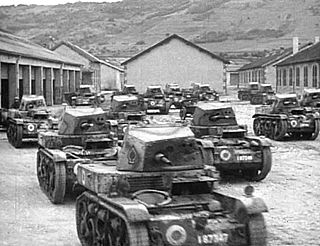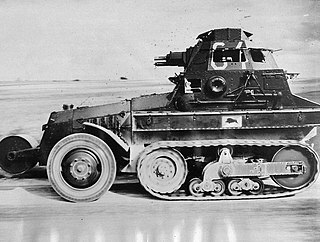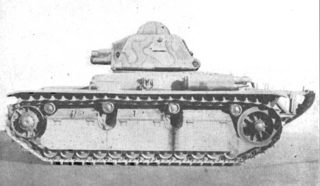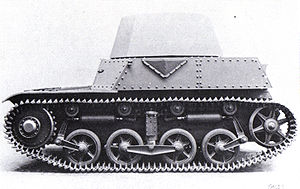
The Char 2C, also known as the FCM 2C, was a French post WWI heavy tank landship, later considered a super-heavy tank. It was developed during World War I but not deployed until after the war. It was, in total volume or physical dimensions, the largest operational tank ever made.

The Automitrailleuse de Reconnaissance Renault Modèle 1933 was a French light cavalry tank developed during the Interbellum and used in the Second World War.

The Automitrailleuse de Reconnaissance Renault Modèle 35 Type ZT was a French light tank developed during the Interbellum and used in the Second World War. It was not intended to reconnoitre and report as its name suggests but was a light armoured combat vehicle, mostly without a radio and used as a support tank for the mechanised infantry.

The Renault R35, an abbreviation of Char léger Modèle 1935 R or R 35, was a French light infantry tank of the Second World War.
This is a list of French combat vehicle production before and during the Second World War. The numbers given are generally those of vehicles actually delivered including exported vehicles. However, it includes those vehicles not yet delivered in June 1940 in the 1940 totals. For the Renault FT only the French metropolitan organic strength and matériel reserve is given. The list excludes those types having been taken out of service by May 1940.

The SOMUA S35 was a French cavalry tank of the Second World War. Built from 1936 until 1940 to equip the armoured divisions of the Cavalry, it was for its time a relatively agile medium-weight tank, superior in armour and armament to its French and foreign competitors, such as the contemporary versions of the German Panzer III medium tank. It was constructed from well-sloped, mainly cast, armour sections, that however made it expensive to produce and time-consuming to maintain.

The AMC 35, also known under a manufacturer's designation Renault ACG-1, was a French medium cavalry tank of the later Interwar era that served in the Second World War. It was developed as a result of the change of the specification that had led to the design of the AMC 34, calling for a vehicle that was not only well-armed and mobile but also well-armoured. Due to technological and financial problems production was delayed and limited. The AMC 35 was one of the few French tanks of the period featuring a two-man turret.

The Char B1 was a French heavy tank manufactured before World War II.

Tanks were initially deployed in World War I, engineered to overcome the deadlock of trench warfare. Between the two world wars, tanks were further developed. Although they had demonstrated their battlefield effectiveness, only a few nations had the industrial resources to design and build them. During and after World War I, Britain and France pioneered tank technology, with their models generally serving as a blueprint for other countries. However, this initial advantage would slowly diminish during the 1930s, shifting in favor of the Soviet Union and, to a lesser degree, Nazi Germany.

The Hotchkiss H35 or Char léger modèle 1935 H was a French cavalry tank developed prior to World War II. Despite having been designed from 1933 as a rather slow but well-armoured light infantry support tank, the type was initially rejected by the French Infantry because it proved difficult to steer while driving cross-country, and was instead adopted in 1936 by the French Cavalry arm.

The FCM 36 or Char léger Modèle 1936 FCM, was a light infantry tank that was designed for the French Army prior to World War II. It had a crew of two and was equipped with a short 37mm main armament and a 7.5mm coaxial machine gun.

The Panhard 178 or "Pan-Pan" was an advanced French reconnaissance 4x4 armoured car that was designed for the French Army Cavalry units before World War II. It had a crew of four and was equipped with an effective 25 mm main armament and a 7.5 mm coaxial machine gun.

The AMC Schneider P 16, also known as the AMC Citroën-Kégresse Modèle 1929 or the Panhard-Schneider P16, was a half-track that was designed for the French Army before World War II.

The Renault R40 or Char léger modèle 1935 R modifié 1939 was a French light infantry tank that was used early in World War II, an improvement of the Renault R35, of which it is often considered a variant.

The Char D2 was a French medium tank of the interwar period.

The Char D1 was an Interwar French light tank.
The Char G1 was a French replacement project for the Char D2 medium tank. Several prototypes from different companies were developed from 1936 onwards, but not a single one had been fully completed at the time of the Fall of France in 1940. The projects represented some of the most advanced French tank design of the period and finally envisaged a type that would have been roughly equal in armament and mobility to later World War II standard tanks of other nations, such as the Soviet T-34 and the American M4 Sherman, but possessing several novel features, such as gun stabilisation, a semi-automatic loader and an optical rangefinder.

French development into tanks began during World War I as an effort to overcome the stalemate of trench warfare, and largely at the initiative of the manufacturers. The Schneider CA1 was the first tank produced by France, and 400 units were built. The French also experimented with various tank designs, such as the Frot-Laffly landship, Boirault machine and Souain experiment. Another 400 Saint-Chamond tanks were manufactured from April 1917 to July 1918 but they were underpowered and were of limited utility because the caterpillar tracks were too short for the tank's length and weight. The most significant French tank development during the war was the Renault FT light tank, which set the general layout for future tank designs and was used or redesigned by various military forces, including those of the United States.

The Vickers T-15 light tank, full designation Char Léger de Reconnaissance Vickers-Carden-Loyd Mod.1934 T.15, was a light 4-ton tank of the Belgian Army. They were built by Vickers-Armstrong in the UK to the design of their Light Tank Mark III and outfitted with their armament in Belgium by Fonderie Royale de Canons (FRC) at Herstal. It entered service in 1935, and was used by the Belgian Army during the Battle of Belgium in May 1940. Its main armament was a 13.2 mm Hotchkiss machine gun. The tank was intended as a replacement for the venerable but obsolescent Renault FT. Only 42 were produced.

The Gendron-Somua AMR 39 was a prototype French armoured car.


















